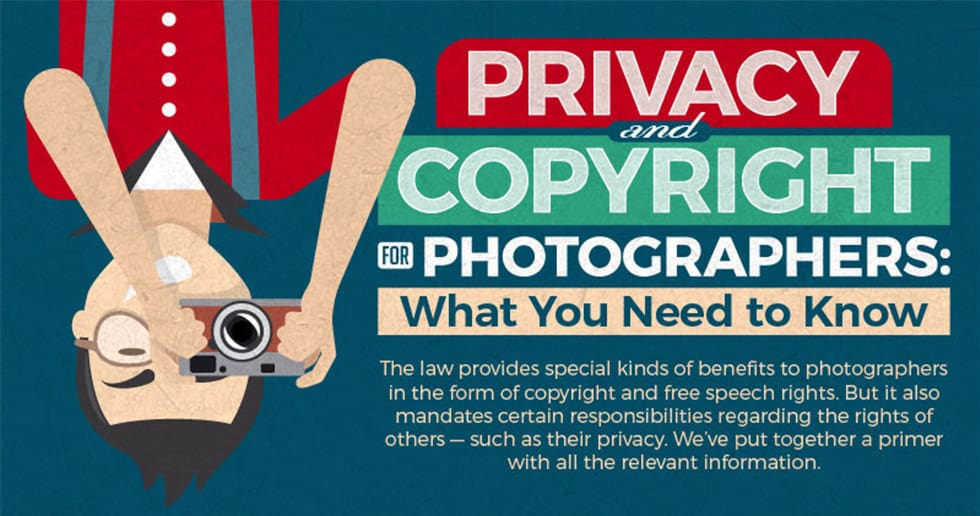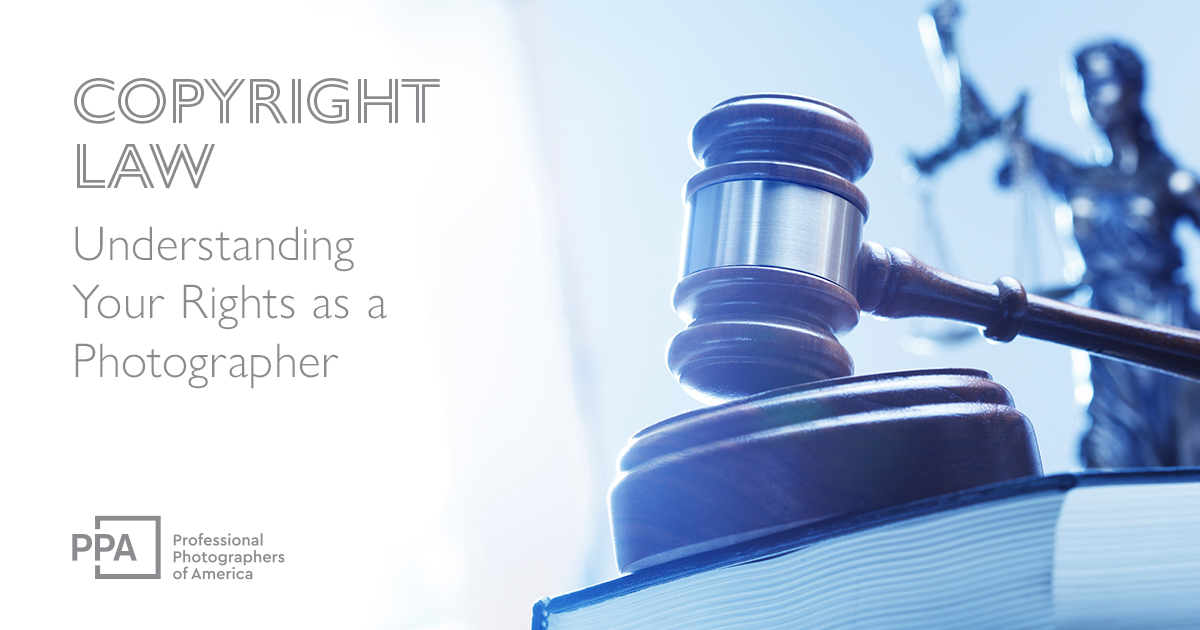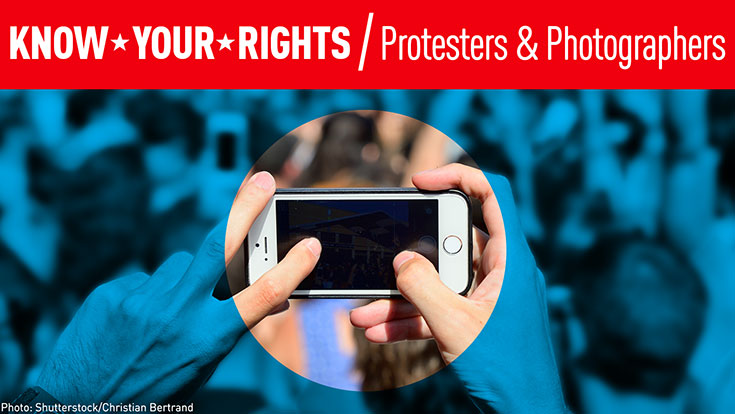Protesters and Photographers Know Your Rights
No matter who you are you have the First Amendment right to:
Peacefully assemble and protest in public spaces and photograph and videotape the police or anything else in a public space.
Here’s the deal:
Public spaces include streets, sidewalks, and public parks.
Private property owners can set rules for public entry (like a theater saying “no cell phones”).
The right to take photos does not give you the right to:
Go places you’re not otherwise allowed, record audio of other people’s private, conversations, trespass, or interfere with police engaged in legitimate law enforcement operations.
Police officers may not: confiscate or demand to view your digital photos or videos without a warrant, or delete your photos or videos under any circumstances.
If you’re stopped or detained for taking photos:
- Be polite.
- Don’t resist.
- Ask, “Am I free to go?”
- If the officer says “no,” you are being detained.
- If you are detained, ask what crime you’re suspected of committing.
Until you ask to leave, being stopped is considered voluntary.
- Remind the officer that taking photographs is your First Amendment right and does not constitute reasonable suspicion of criminal activity.
If you believe any right listed here has been violated, contact your local ACLU! source
 PHOTOGRAPHERS’ RIGHTS
PHOTOGRAPHERS’ RIGHTS
Taking photographs of things that are plainly visible from public spaces is a constitutional right – and that includes federal buildings, transportation facilities, and police and other government officials carrying out their duties. Unfortunately, there is a widespread, continuing pattern of law enforcement officers ordering people to stop taking photographs from public places, and harassing, detaining and arresting those who fail to comply.
Your rights as a photographer:
- When in public spaces where you are lawfully present you have the right to photograph anything that is in plain view. That includes pictures of federal buildings, transportation facilities, and police. Such photography is a form of public oversight over the government and is important in a free society.
- When you are on private property, the property owner may set rules about the taking of photographs. If you disobey the property owner’s rules, they can order you off their property (and have you arrested for trespassing if you do not comply).
- Police officers may not generally confiscate or demand to view your photographs or video without a warrant.If you are arrested, the contents of your phone may be scrutinized by the police, although their constitutional power to do so remains unsettled. In addition, it is possible that courts may approve the seizure of a camera in some circumstances if police have a reasonable, good-faith belief that it contains evidence of a crime by someone other than the police themselves (it is unsettled whether they still need a warrant to view them).
- Police may not delete your photographs or video under any circumstances.
- Police officers may legitimately order citizens to cease activities that are truly interfering with legitimate law enforcement operations. Professional officers, however, realize that such operations are subject to public scrutiny, including by citizens photographing them.
- Note that the right to photograph does not give you a right to break any other laws. For example, if you are trespassing to take photographs, you may still be charged with trespass.
If you are stopped or detained for taking photographs:
- Always remain polite and never physically resist a police officer.
- If stopped for photography, the right question to ask is, “am I free to go?” If the officer says no, then you are being detained, something that under the law an officer cannot do without reasonable suspicion that you have or are about to commit a crime or are in the process of doing so. Until you ask to leave, your being stopped is considered voluntary under the law and is legal.
- If you are detained, politely ask what crime you are suspected of committing, and remind the officer that taking photographs is your right under the First Amendment and does not constitute reasonable suspicion of criminal activity.
Special considerations when videotaping:
With regards to videotaping, there is an important legal distinction between a visual photographic record (fully protected) and the audio portion of a videotape, which some states have tried to regulate under state wiretapping laws.
- Such laws are generally intended to accomplish the important privacy-protecting goal of prohibiting audio “bugging” of private conversations. However, in nearly all cases audio recording the police is legal.
- In states that allow recording with the consent of just one party to the conversation, you can tape your own interactions with officers without violating wiretap statutes (since you are one of the parties).
- In situations where you are an observer but not a part of the conversation, or in states where all parties to a conversation must consent to taping, the legality of taping will depend on whether the state’s prohibition on taping applies only when there is a reasonable expectation of privacy. But that is the case in nearly all states, and no state court has held that police officers performing their job in public have a reasonable expectation. The state of Illinois makes the recording illegal regardless of whether there is an expectation of privacy, but the ACLU of Illinois is challenging that statute in court as a violation of the First Amendment.
- The ACLU believes that laws that ban the taping of public officials’ public statements without their consent violate the First Amendment. A summary of state wiretapping laws can be found here.
Photography at the airport
Photography has also served as an important check on government power in the airline security context.
The Transportation Security Administration (TSA) acknowledges that photography is permitted in and around airline security checkpoints as long as you’re not interfering with the screening process. The TSA does ask that its security monitors not be photographed, though it is not clear whether they have any legal basis for such a restriction when the monitors are plainly viewable by the traveling public.
The TSA also warns that local or airport regulations may impose restrictions that the TSA does not. It is difficult to determine if any localities or airport authorities actually have such rules. If you are told you cannot take photographs in an airport you should ask what the legal authority for that rule is.
The ACLU does not believe that restrictions on photography in the public areas of publicly operated airports are constitutional.
Tod.ay’s photography cheat sheet is all about the rights and responsibilities of photographers when it comes copyright and privacy
Photographers are among the creatives whose works constantly faces copyright infringement issues. Likewise, many photographers aren’t aware of the responsibilities that come with the job, especially when it comes to street photography. To address this, we’re sharing an infographic that will serve as a handy photography cheat sheet for knowing your rights and responsibilities as a photographer. The infographic below is a primer on what you need to know about privacy and copyright issues you may encounter as a photographer. Knowing about copyright law will allow you to protect your work, while familiarity with the privacy law will allow you to avoid legal liabilities. We highly suggest that you keep a copy of this photography cheat sheet for instances when you’re in doubt.
COPYRIGHT MATTERS
A lot of us are sharing our photos online, whether personal projects or commissioned work, as part of our photography portfolio. We also post them on social media to get the word out about what we do and catch the interest of potential clients. But that also exposes our work to copyright issues like theft and unauthorized commercial use. The infographic tells us that copyright laws vary in different countries, but most implement versions roughly the same as the US copyright law. Any photo that you take is automatically copyrighted to you, and that copyright lasts as long as you’re alive. This means you have exclusive rights to copy and use your photographs and manage how they are used by others. Registering your photos with the Copyright Office is only required if you’re pursuing legal action for copyright infringement and you’re looking into getting greater penalties available.
While there’s no surefire way to protect your work, there are ways to deter downloads and unauthorized use. Among the suggestions in the infographic are watermarking, adding metadata, uploading low-resolution images, and placing a transparent image over your photos using CSS (so only the transparent image will be captured through the Copy + Paste function). JavaScripts and software can also disable copying, downloading, and printing the photos posted on your website.
You can also use the free copyright license offered by Creative Commons to choose the conditions through which the public can access and share your photos. If you use Behance for your professional portfolio, you might already be familiar with it. Keep in mind that Creative Commons does not replace the actual copyright terms, but works alongside it.
If you find that the copyright of one or some of your photos was infringed, the infographic has also outlined what you can do. It provides suggestions for documenting the infringement, contacting the infringer, and pursuing legal action.
There are also copyright issues that can arise on the part of the photographer. Keep in mind that objects you photograph like paintings, sculpture, and exhibited photos can be copyrighted.
PRIVACY MATTERS
Privacy laws, meanwhile, fall under the responsibilities that photographers need to keep in mind to avoid costly legal liabilities. Privacy concerns from the subjects you photograph — something that street photographers are typically familiar with. Generally, people’s recognizable bodies are protected from being photographed for commercial purposes without their permission. It also applies in locations that are private, such as their homes and public restrooms. You can also photograph public officials on duty as well as buildings and other property if you’re in a public space. Before you go out prowling the streets, make sure to brush up on the privacy laws of the city, state, or country you’re in for any specifics.
To protect yourself from lawsuit liabilities for defamation of character and invasion of privacy, make sure you prepare a model release between yourself and your models. You can download some samples online and tailor it to include details about your shoot and how the photos may be used. A release is also necessary if you’re shooting for commercial uses such as advertising, catalogs, promotions, and websites. The same goes for subjects who are recognizable through their faces, tattoos, or involvement in specific activities.
This cheat sheet is only meant to be a rough guide, so we highly suggest doing some additional research. When in doubt about any privacy or copyright issue, consulting a lawyer is your best course of action.Looking for more useful photography tips and tricks? Make sure to check out all our photography cheat sheets so far! source

Copyright Law: Understanding Your Rights as a Photographer

In the age of social media, a clear understanding of your rights as a photographer is crucial to receiving the credit you deserve. But with so much information out there, you might find yourself asking:
- What laws are in place to protect photographers like me?
- What do I do if someone uses my photo without permission?
- How long do photographers have ownership of their images?
Here you will find an overview of what copyright law is and how it impacts your photography business. We’ll also take a look at the downloadable copyright resources and copyright infringement tools available to PPA members.
What is Copyright?
Copyright law in the United States prohibits the unauthorized copying of a “work of authorship.” In 1988, the following amendment was added to address visual works including photography:
“Pictorial, graphic, and sculptural works” include two-dimensional and three-dimensional works of fine, graphic, and applied art, photographs, prints and art reproductions, maps, globes, charts, diagrams, models, and technical drawings, including architectural plans. Such works shall include works of artistic craftsmanship insofar as their form but not their mechanical or utilitarian aspects are concerned; the design of a useful article, as defined in this section, shall be considered a pictorial, graphic, or sculptural work only if, and only to the extent that, such design incorporates pictorial, graphic, or sculptural features that can be identified separately from, and are capable of existing independently of, the utilitarian aspects of the article.”
Phew. That’s a mouthful of legalese! So what does it mean in English? Basically, copyright law says that when you take a photograph, you become the copyright owner of the image created. This means you hold exclusive rights to:
- Reproduce the photograph
- Display the image in a public space
- Distribute the photo
- Create derivatives of the image
Seems straightforward, no? But what’s considered a “derivative?”
A “new version” of a work that is already copyrighted falls under the term of a “derivative” work. Special re-edits of movies, art reproductions, and literary translations all qualify as derivatives. A film based on a book or play is another common example.
In the realm of photography, any time someone creates a photograph that is a copy or “substantially similar” to another copyrighted work, they are potentially infringing upon the original owner’s rights.
By comparing and evaluating a derivative work to the original, a court of law can determine if any copyright laws have been violated. In other words, a photographer who went to great lengths to recreate an original work’s composition, lighting, and other creative elements would be more likely to be found guilty of copyright infringement than a photographer who simply takes pictures of subjects that already exist in other photos (i.e., monuments, nature). This means many different photographers can take photos of, say, the Golden Gate Bridge without infringing on each other’s artistic rights.
If you suspect your image has been used without your permission, use PPA’s copyright infringement tool to help you determine your next steps.
Mercedes Benz & Detroit’s Eastern Market Murals
In addition to looking out for your own rights, you as a photographer need to be aware of ways you may unknowingly infringe upon another artist’s rights. The last thing you want to do is misuse another creative’s work!
Take for example Mercedes Benz’s 2018 ad campaign featuring the company’s new vehicle “barreling through Detroit’s boho Eastern Market district past commercial buildings painted with vibrant murals.” Cool concept, no doubt. But the artists who created those murals that contributed so much color and atmosphere to the campaign were never asked permission to use their work, let alone credited:
“While Mercedes sought municipal permission to make beautiful shots of its vehicles on public city streets, it did not seek the muralists’ permission to make and post images of their works on Instagram. Copyright infringement? Mercedes thought not. The muralists—James Lewis, Jeff Soto, Maxx Gramajo, and Daniel Bombardier—thought otherwise.”
Read the full story at PPmag.com. The Mercedes Benz ad campaign is important for two reasons:
- It shows the importance of being aware of how others’ work appears in your photographs
- It serves as an example of how your work may be misused
The exception to copyright law is when the reproduction of a photograph or visual work is deemed “fair use.” The next section digs deeper into this term.
Fair Use
Fair use is an exception when it comes to copyright law. Journalism, critiques, research, and teaching materials are examples of specific types of writing that allow the reproduction of copyright-protected works without the permission of the “author”.
For example, if you exhibit your photography in a gallery, an art publication generally does not need permission to reproduce your image if they’re using it as part of a critique. Or, conversely, a newspaper may publish photographs of works and use them as part of an article. Both of these are examples of copyrighted work being used under “fair use” guidelines.
When considering whether a reproduction of a work is fair use, the U.S. Copyright Act says “the factors to be considered shall include whether:
- The use is of commercial nature or if it is for nonprofit education purposes
- The copyrighted work is highly creative or if it is fact-based
- Part of the entire original work was reproduced or just a part of it
- The reproduction reduces the value of the original work or has no effect
One important thing to keep in mind is that social media marketing’s use of images very rarely falls under “fair use.” If your photographic work is being used without your permission, check out the resources from PPA below for help determining if you need to take further action.
Resources
Remember: If a company uses one of your images in their marketing—on social media or otherwise—without your approval, they are violating your rights as a creator. So, what do you do if you suspect your work of being used without your permission? PPA has resources to help you understand copyright law, and even a Copyright Infringement Tool to leave no question in your mind whether or not your rights as a creator have been violated. source
Sources:
https://ppmag.com/news/photographers-should-be-cautious-about-using-murals-as-backdrops
https://blog.hootsuite.com/understanding-image-copyright/
https://www.legalzoom.com/articles/what-are-derivative-works-under-copyright-law
https://copyright.gov/title17/92chap1.html
FEDERAL US LAW
§ 102-74.420 What is the policy concerning photographs for news, advertising or commercial purposes?
Except where security regulations, rules, orders, or directives apply or a Federal court order or rule prohibits it, persons entering in or on Federal property may take photographs of—
- (a) Space occupied by a tenant agency for non-commercial purposes only with the permission of the occupying agency concerned;
- (b) Space occupied by a tenant agency for commercial purposes only with written permission of an authorized official of the occupying agency concerned; and
- (c) Building entrances, lobbies, foyers, corridors, or auditoriums for news purposes.


